Design, Implementation and Demonstration of Embedded Agents for Energy Management in Non-Residential Buildings
Abstract
:1. Introduction
- providing an ontology for MAS in buildings and a data model for the application to non-residential buildings, both of which were developed with a focus on existing standards and are re-usable and expandable
- presenting a validation platform, which allows a swift transition from simulation testing to a field-test experiment
- assessing the feasibility of embedding the agents in the intelligence of the energy components, by programming them on BeagleBone Blacks using Java
2. Concept
- the different kind of energy supply agents in our systems, not all of them necessarily electrically powered (e.g., a boiler)
- the choice of energy supply agent based on merit order, and not a market price
- basing the concept on an ontology with attached data model for our application
2.1. Ontology
- Domain: generation, distribution, storage, delivery, customer
- Zone: building, process, supply circuit, room. The supply circuits are of several types: electrical, air, hot/cold water
2.2. Data Model
- Descriptions, containing information on name, type, model, energy data, domain, zone and fixed energy costs.
- Measured and metered values, containing information on energy data such as current operation point, delivered energy and variable energy costs.
- Settings and controls, providing information on the type of communication used by the agent to the device (TCP/IP, BACnet), control mode of the device and set point types.
- Status contains information such as heating or cooling mode and information on the health of the device (ok, alarm, waning, out of service).
3. Design and Implementation
3.1. Use Cases
- Default, meaning the comfort conditions must be satisfied in the room, without further constraints.
- Optimization of energy costs, where only the most cost effective energy supply option to the room is executed.
- Relaxation of the comfort constraint, where the possible productivity gain from increased comfort is compared to the energy supply costs for achieving this comfort level. The energy is supplied to the room, only if the monetary productivity gain is higher than the energy supply costs.
- The room agent monitors the room temperature (received from the sensor) against the desired room temperature (received from the comfort agent-arrow with number 1). If the room air temperature lies outside a tolerance interval around the desired temperature, a call for proposal is send to the relevant energy supply agents that are connected to the supply circuit of the room and can supply energy (heat pump and circulation pump) (2). Additionally a request for the comfort costs is send to the comfort agent (1 *).
- The energy supply agents send their costs and the amount of power they can produce (3).
- The room agent compares the costs for supplying the energy against each other. The option with the lower costs is executed.
- If energy can be provided to the room, the room agent sends a request to the energy supply agent with the lowest costs (4). In this use case the pump, if chosen, will forward the request to a valve that can directly control the volume flow (4 *). Once the action is performed the valve sends a confirmation back to the pump (4 *).
- The energy supply agent sends an inform message to the room agent on how the command was executed (5).
- The room agent informs the comfort agent on how the action for improving the room conditions was executed (6).
3.2. Demonstration
3.3. Agent Platform
- the sender.
- the receiver(s).
- the communicative act that represents the intention of the sender of the message. The FIPA standard defines 22 types of communicate acts, with the most used being: INFORM. REQUEST, CFP. We used only the types of communicate acts defined by FIPA.
- the content i.e., the actual information included in the message.
- Analyse Room Conditions: this behavior is always started if new data is received in Handle Temp Sensor Data Subscription and it is not already running. It analyses and evaluates the current room conditions. If improvements are required, it starts the Initiate Contract Net For Energy Supply behavior. If comfort costs are to be considered, Initiate Prod Loss Cost Request is started first.
- Update Room Characteristics Ticker: this behavior updates the room characteristics (thermal capacity and resistance) every 15 min.
- Handle Comfort Agent Subscription: this behavior is initiated whenever a Comfort Agent registration is detected. This behavior receives and handles the notifications from the publishing Comfort Agent it subscribed to. A Comfort Agent General Data structure is transmitted from the Comfort Agent.
- Handle Electricity Info Subscription: this behavior is initiated whenever an Electricity Info Agent registration is detected. This behavior receives and handles the notifications from the publishing Electricity Info Agent it subscribed to. The electricity price is transmitted from the Electricity Info Agent.
- Handle Temp Sensor Data Subscription: this behavior is initiated whenever a Sensor Agent Temperature registration is detected. This behavior receives and handles the notifications from the publishing Sensor Agent Temperature it subscribed to. It triggers the Analyse Room Conditions behavior every time a temperature update is received.
- Initiate Shut down Request: if the last Comfort Agent deregisters from the room, this behavior is initiated, to send a shutdown request to the Energy Supply Agents. It is triggered from Auto Subscribe To Comfort Agent.
- Initiate Prod Loss Cost Request: this behavior sends a request to the Comfort Agent to get the costs, the current conditions create, due to reduction in productivity. It also handles the answer.
- Initiate Contract Net For Energy Supply: this behavior is initiated from Analyse Room Conditions, if there is a need to improve the room conditions. It starts a CFP to the Energy Supply Agents, evaluates the proposal requests the execution of the proposal.
3.4. Cost Functions
3.5. Simulation Models and Set-Ups
- Technical equipment: heat pump, boiler, circulating pump, radiator and fan coil (as a model for the facade ventilation unit)
- Building: room with walls, windows and doors
- Internal gains from persons present in the rooms
- Boundary conditions, mainly weather model
- the supply temperature for the heat pump is set according to a heating curve, depending on outside air temperature and the characteristics of the building
- the room temperature control is done via thermostatic valves
3.6. Field Test Set-Up
- to test the communication between agents and their devices in a real network, where unexpected delays or failures may occur
- to test the system with real technical equipment in a real building
- to allow for a more dynamical interaction with the user
4. Validation
4.1. Performance Indicators
- Energy consumption: kWh or €
- Comfort
- ‒
- Absolute deviation from set temperature in
- ‒
- Absolute deviation outside of tolerance interval in
- ‒
- Mean value and variance of deviation from set temperature in K
- ‒
- Costs for lost productivity: €
- ‒
- As a qualitative measure, through the feedback from the comfort agent, which offers an array of information over room temperature, outside temperature, current productivity and comfort costs, as well as the responses from the room agent the occupant starts to think on the way he/she perceives personal comfort and how it is connected to other variables.
4.2. Simulation-Two Rooms Use Case
- both room air temperatures stay in the tolerance interval around each set temperature
- as the heat pump supplies both rooms and room R1 has a higher demand, during the hours the occupants are present, the valve opening in room R1 should be consistently higher than the one in room R2
- the flow temperature of the heating pump should set on a mean value which is lower than the one given by a heating curve
4.3. Field Test
- Completely new component: a new component is introduced in the system, be it a sensor, a valve or a pump
- Replacement of an existing component: an old component is replaced by a new component.
5. Conclusions and Outlook
Acknowledgments
Author Contributions
Conflicts of Interest
References
- International Energy Agency. Building Energy Performance Metrics: Supporting Energy Efficiency Progress in Major Economies; Technical report; IEA: Paris, France, 2015. [Google Scholar]
- International Energy Agency. Energy Technology Perspectives 2015; Technical report; IEA: Paris, France, 2015. [Google Scholar]
- Shaikh, P.H.; Nor, N.B.M.; Nallagownden, P.; Elamvazuthi, I.; Ibrahim, T. A review on optimized control systems for building energy and comfort management of smart sustainable buildings. Renew. Sustain. Energy Rev. 2014, 34, 409–429. [Google Scholar] [CrossRef]
- Labeodan, T.; Aduda, K.; Boxem, G.; Zeiler, W. On the application of multi-agent systems in buildings for improved building operations, performance and smart grid interaction A survey. Renew. Sustain. Energy Rev. 2015, 50, 1405–1414. [Google Scholar] [CrossRef]
- Russell, S.J.; Norvig, P. Artificial Intelligence A Modern Approach; Prentice Hall/Pearson Education, 2003. [Google Scholar]
- Constantin, A.; Ponci, F.; Löwen, A.; Isermann, T.; Müller, D. Agent-Based Control for Non-Residential Buildings; E.ON Energy Research Center: Aachen, Germany, 2016; Volume 8, p. 74. [Google Scholar]
- Kok, K.; Warmer, C.; Kamphuis, R. PowerMatcher: multiagent control in the electricity infrastructure. In Proceedings of the 4th International Joint conference on Autonomous Agents and Multiagent Systems, Utrecht, Netherlands, 25–29 July 2005; industry track. pp. 75–82. [Google Scholar]
- Gruber, T.R. A translation approach to portable ontology specifications. Knowl. Acquis. 1993, 5, 199–220. [Google Scholar] [CrossRef]
- Spyns, P.; Meersman, R.; Jarrar, M. Data modelling versus ontology engineering. ACM SIGMOD Rec. 2002, 31, 12. [Google Scholar] [CrossRef]
- Noy, N.F.; McGuiness, D.L. Ontology Development 101: A Guide to Creating Your First Ontology: Stanford Knowledge Systems Laboratory Technical Report KSL-01-05 and Stanford Medical Informatics; Technical Report SMI-2001-0880; Stanford University: Stanford, CA, USA, 2001. [Google Scholar]
- Musen, M.A. The Protégé project: a look back and a look forward. Artificial Intelligence 2015, 1, 4–12. [Google Scholar] [CrossRef] [PubMed]
- van Dam, K.H. Capturing Socio-Technical Systems with Agent-Based Modelling. PhD Thesis, Delft University of Technology, Delft, Netherlands, Next Generation Infrastructures Foundation. 30 October 2009. [Google Scholar]
- Dibley, M.; Li, H.; Rezgui, Y.; Miles, J. An ontology framework for intelligent sensor-based building monitoring. Autom. Constr. 2012, 28, 1–14. [Google Scholar] [CrossRef]
- Smart Grid Coordination Group. Smart Grid Reference Architecture; Technical report; Smart Grid Coordination Group: Bruxelles, Belgium, 2012. [Google Scholar]
- Foundation for Intelligent Physical Agents. Device Ontology Specification, SC00091E; Foundation for Intelligent Physical Agents: Geneva, Switzerland, 2002. [Google Scholar]
- Foundation for Intelligent Physical Agents. Communicative Act Libary Specification SC00037J; Foundation for Intelligent Physical Agents: Geneva, Switzerland, 2002. [Google Scholar]
- Grimshaw, D. JADE Administration Tutorial; Ryerson University: Toronto, ON, Canada, 2010. [Google Scholar]
- Corrado, V.; Ballarini, I.; Madrazo, L.; Nemirovskij, G. Data structuring for the ontological modelling of urban energy systems: The experience of the SEMANCO project. Sustain. Cities Soc. 2015, 14, 223–235. [Google Scholar] [CrossRef]
- International Electrotechnical Commission. Communication Networks and Systems for Power Utility Automation Part 7-4: Basic Communication Structure-Compatible Logical Node Classes and Data Object Classes, IEC EN 61850-7-4; Number IEC EN 61850-7-4; International Electrotechnical Commission: Geneva, Switzerland, 2010. [Google Scholar]
- International Organization for Standardization. Industry Foundation Classes (IFC) for Data Sharing in the Construction and Facility Management Industries, ISO 16739:2013; Number ISO 16739; International Organization fo Standardization: Geneva, Switzerland, 2013. [Google Scholar]
- Smart Grid Coordination Group. Use Case Collection, Management, Repository, Analysis and Harmonization; Draft report; Smart Grid Coordination Group Sustainable Processes: Bruxelles, Belgium, 2012. [Google Scholar]
- International Electrotechnical Commission. Intelligrid Methodology for Developing Requirements for Energy Systems; Number IEC/PAS 62559; International Electrotechnical Commission: Geneva, Switzerland, 2008. [Google Scholar]
- Fütterer, J.; Constantin, A.; Müller, D. An energy concept for multifunctional buildings with geothermal energy and photovoltaic. Proceedings of CISBAT 2011: Cleantech for sustainable buildings from nano to urban scale, Lausanne, Switzerland, 14–16 September 2011; Volume 1–2. [Google Scholar]
- Seppaenen, O.; Fisk, W.; Lei, Q. Effect of Temperature on Task Performance in Offfice Environment; Technical report; Orlando Lawrence Berkley National Laboraory: Berkeley, CA, USA, 2006. [Google Scholar]
- American Society of Heating, Refrigerating and Air-Conditioning Engineers. BACnet: A Data Communication Protocol for Building Automation and Control Networks; Number ASHRAE 135; American Society of Heating, Refrigerating and Air-Conditioning Engineers: New York, NY, USA, 2016. [Google Scholar]
- Constantin, A.; Löwen, A.; Ponci, F.; Huchtemann, K.; Müller, D. Dymola-JADE Co-Simulation for Agent-Based Control in Office Spaces. In Proceedings of the 12th International Modelica Conference, Prague, Czech Republic, 15–17 May 2017. [Google Scholar]
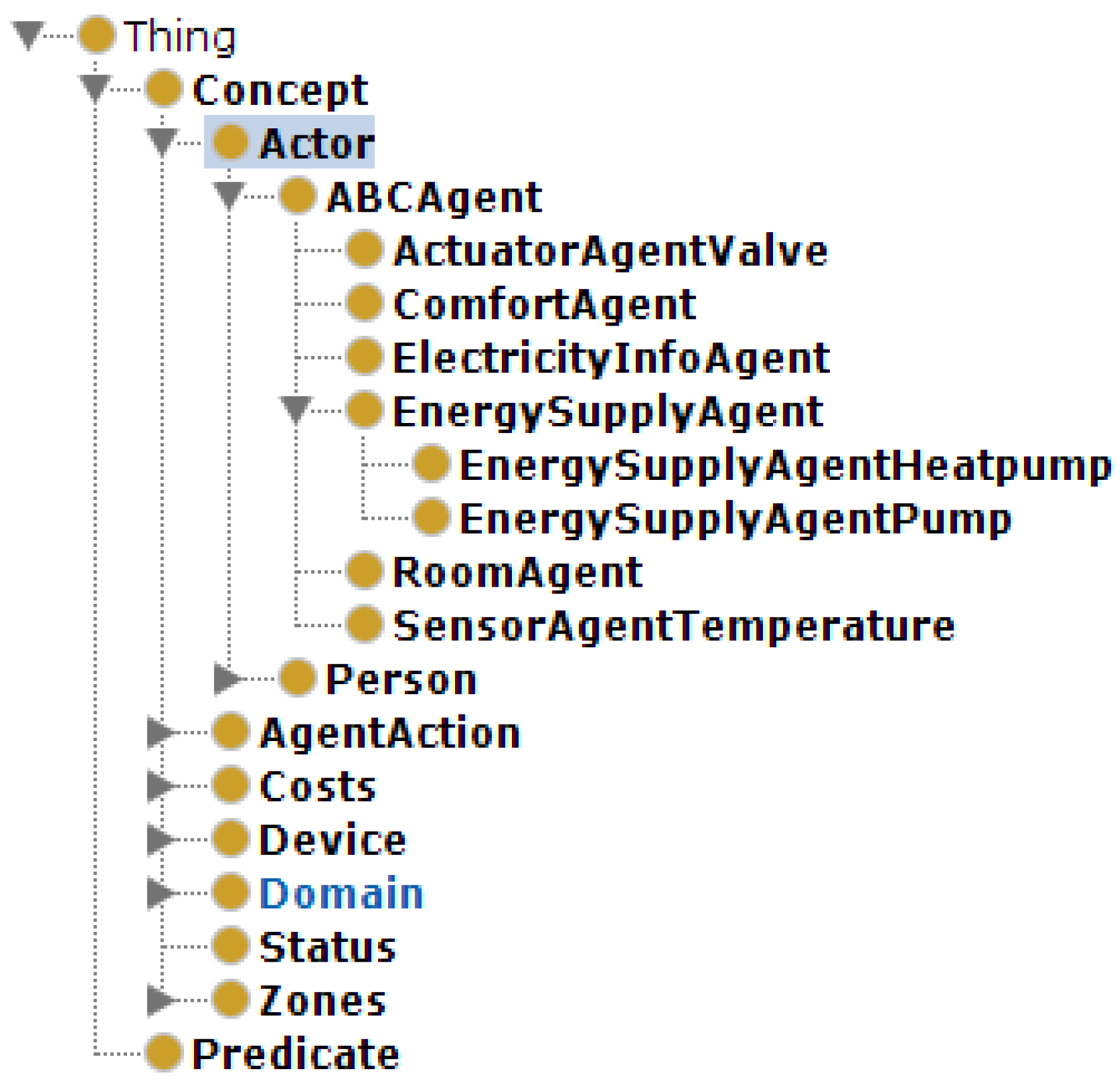
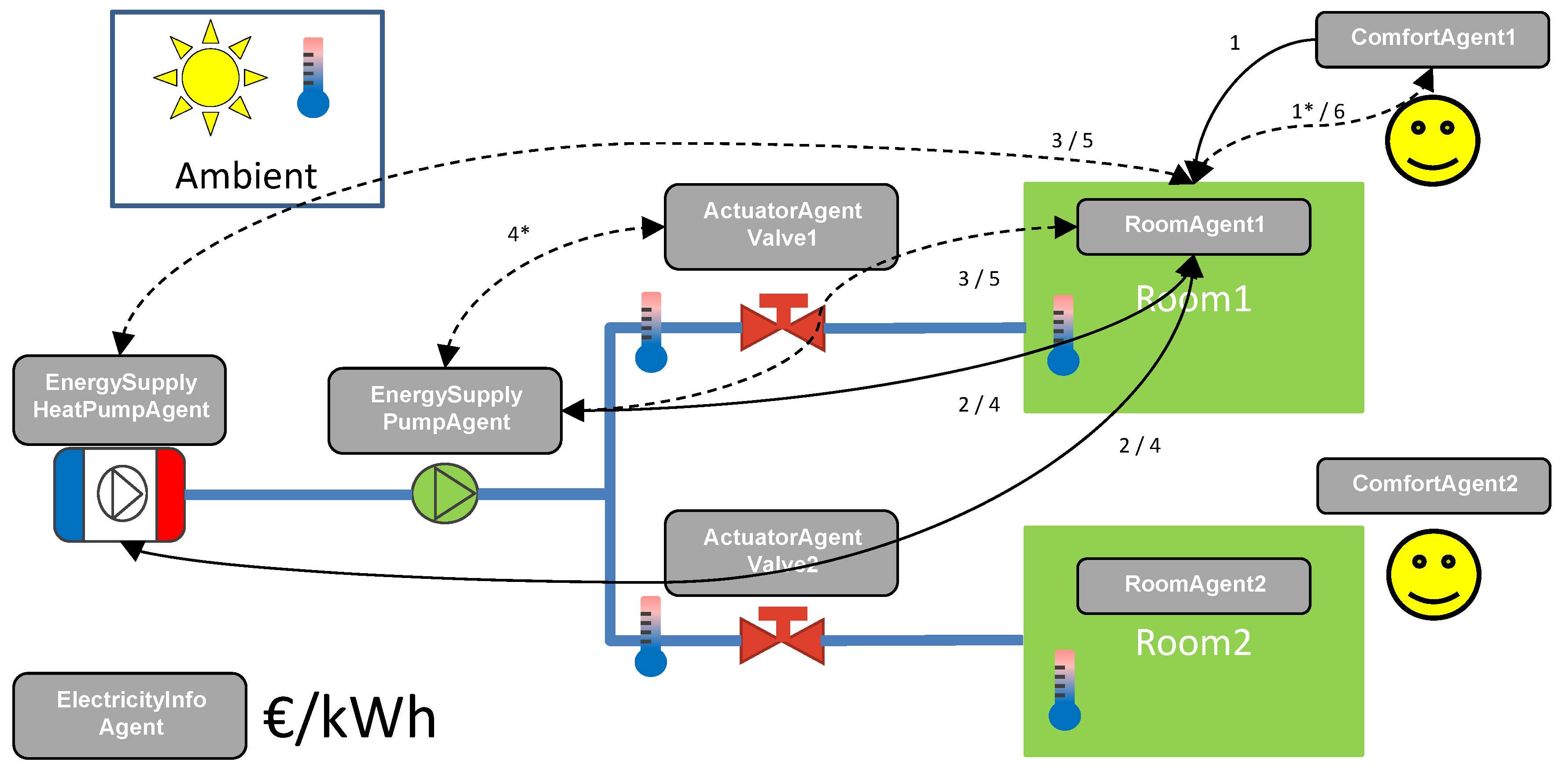
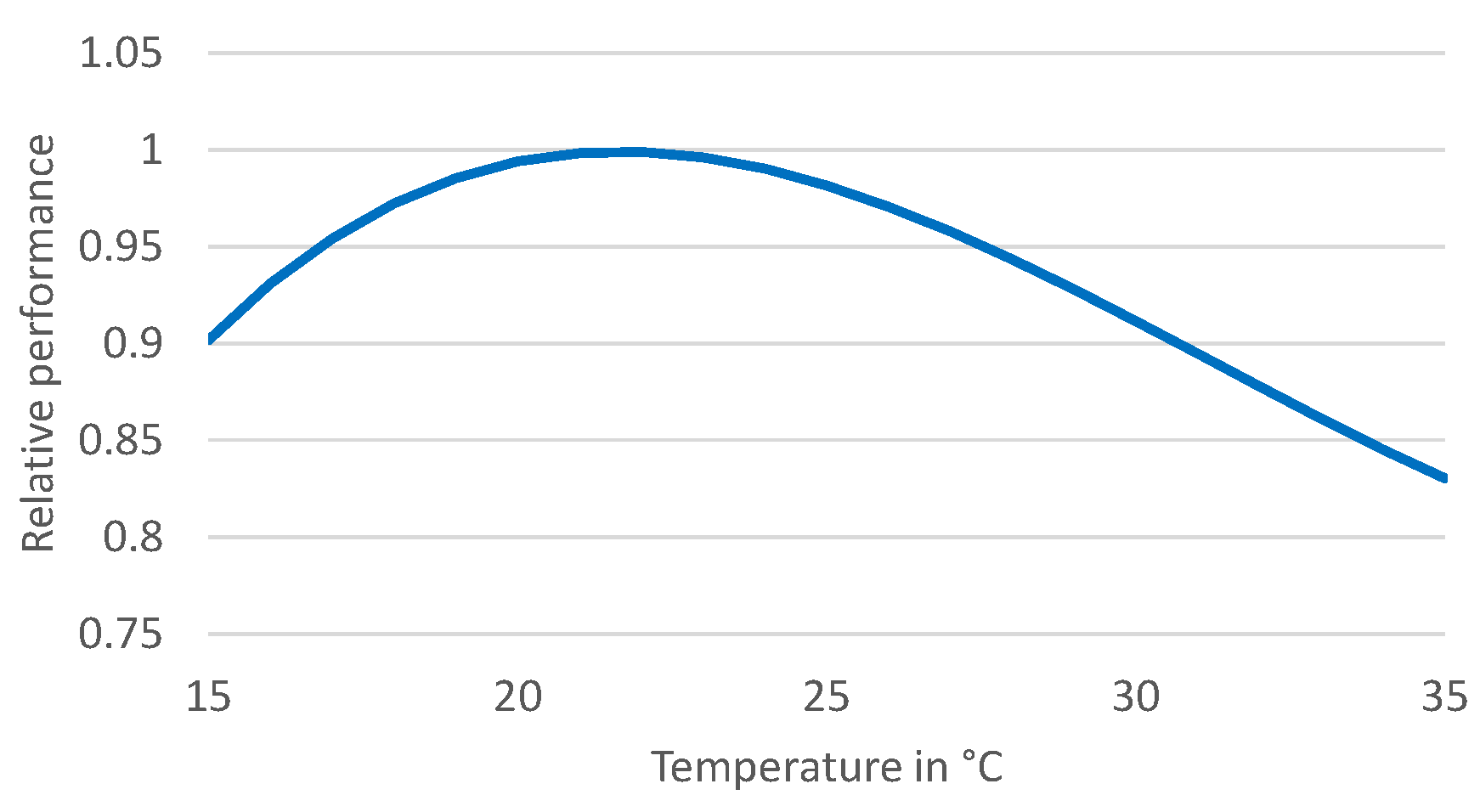

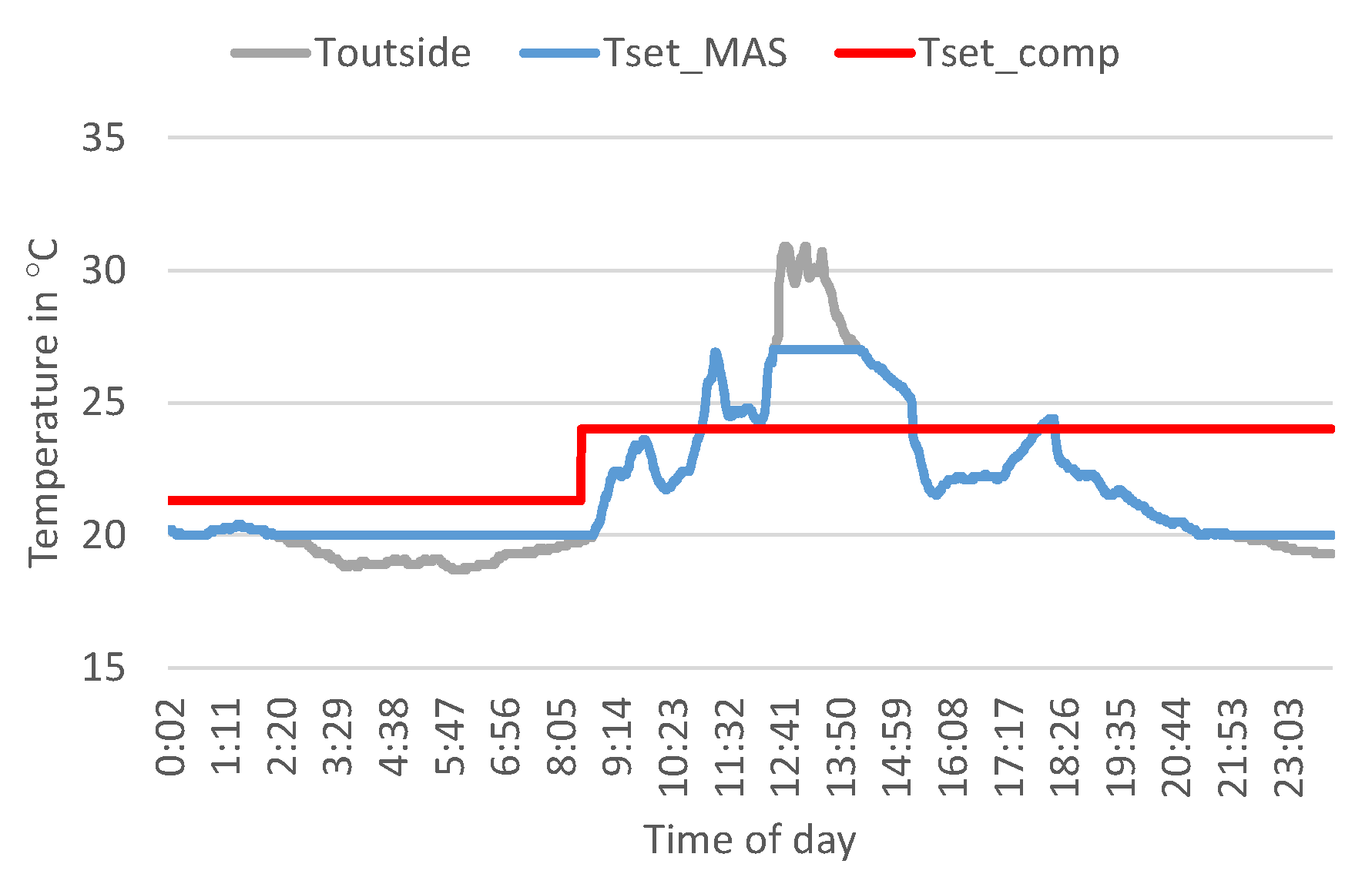
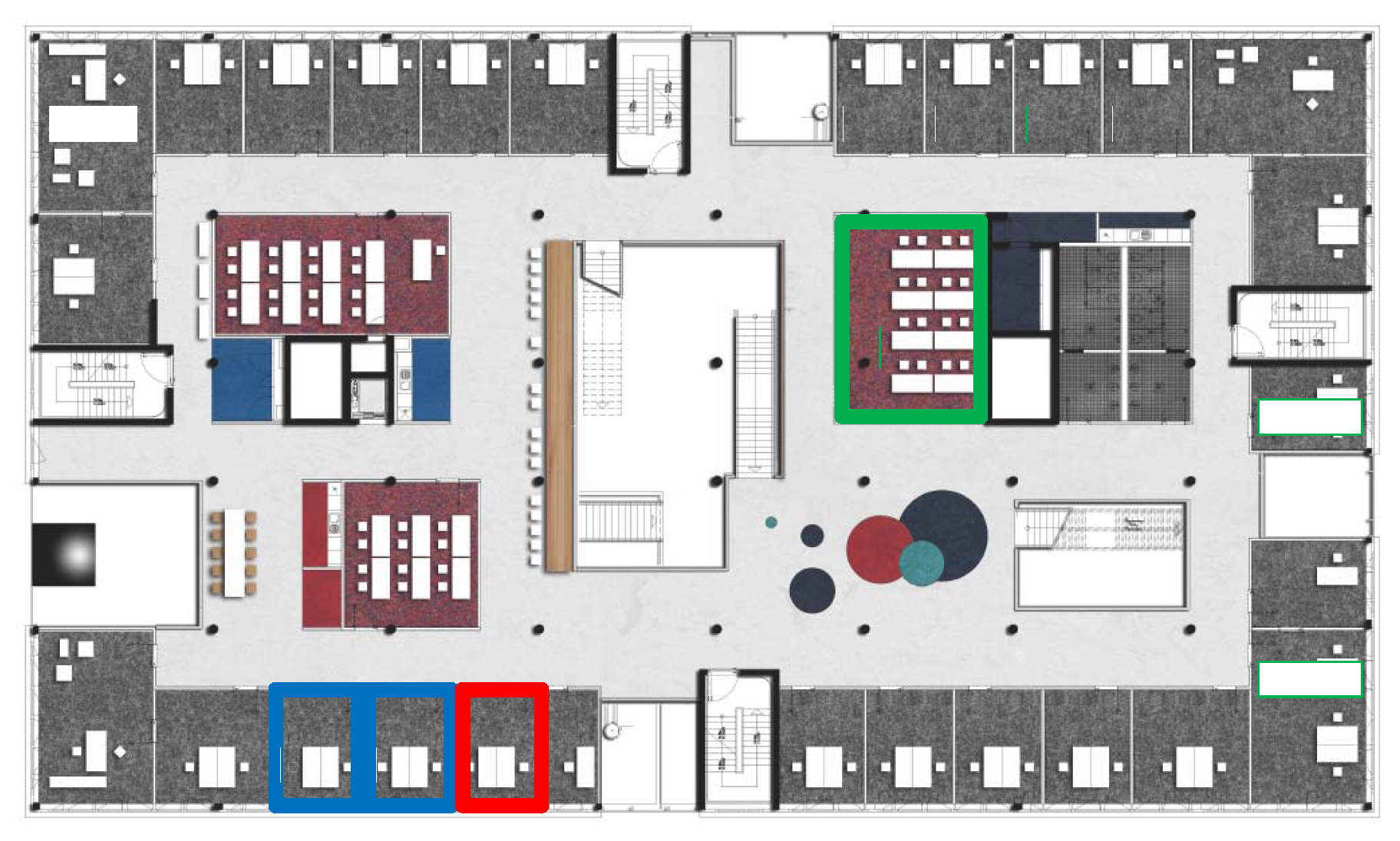
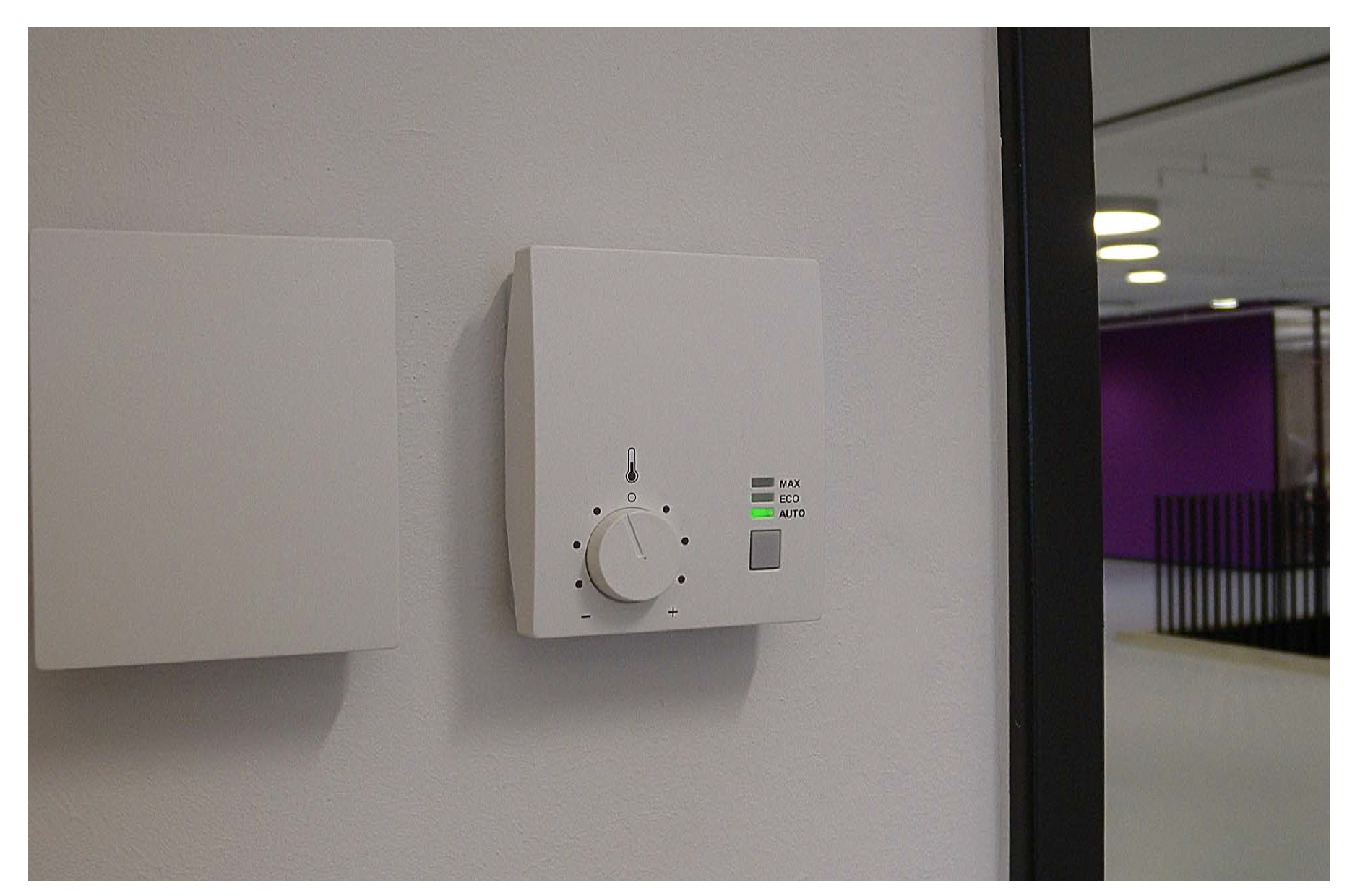
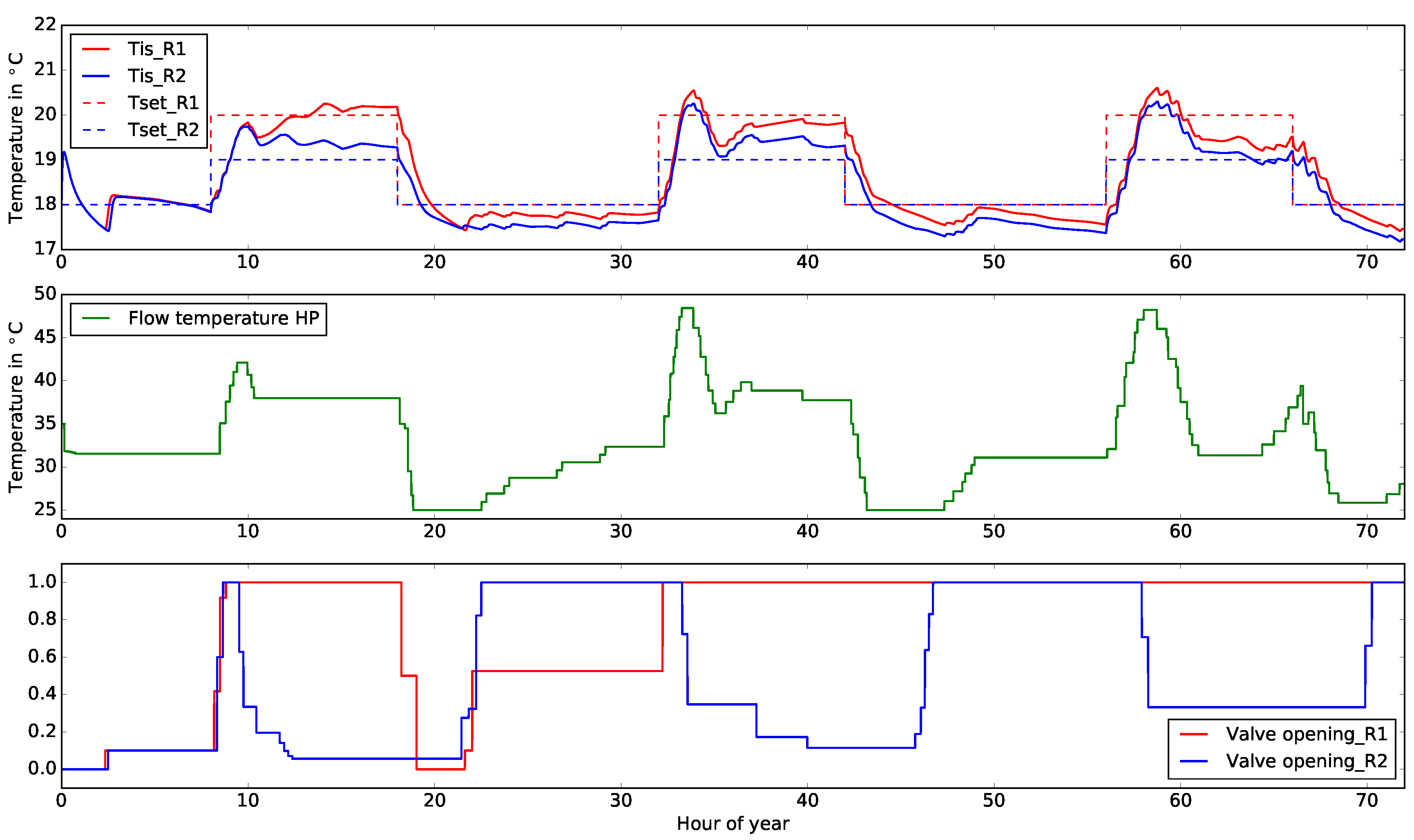

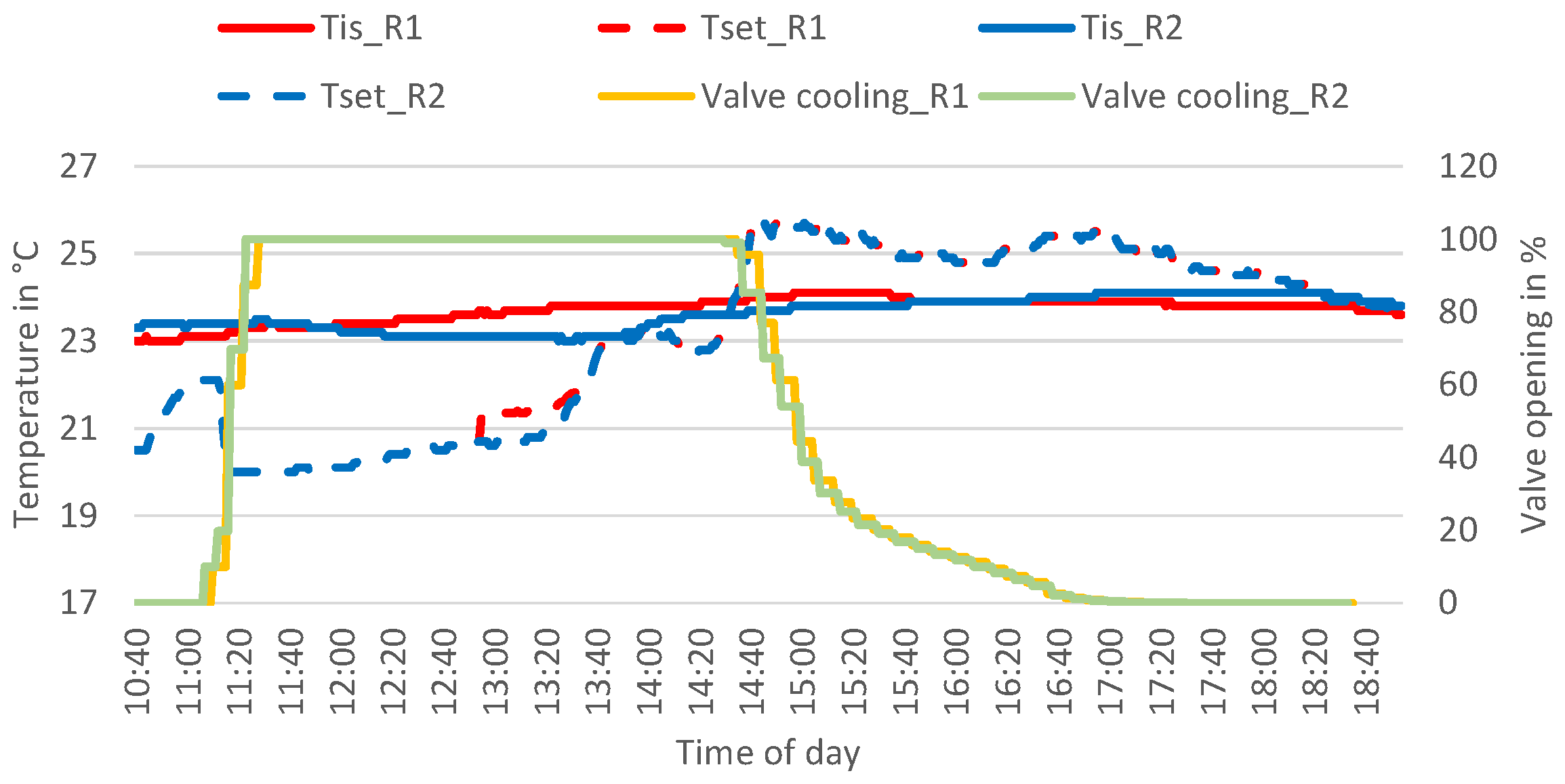
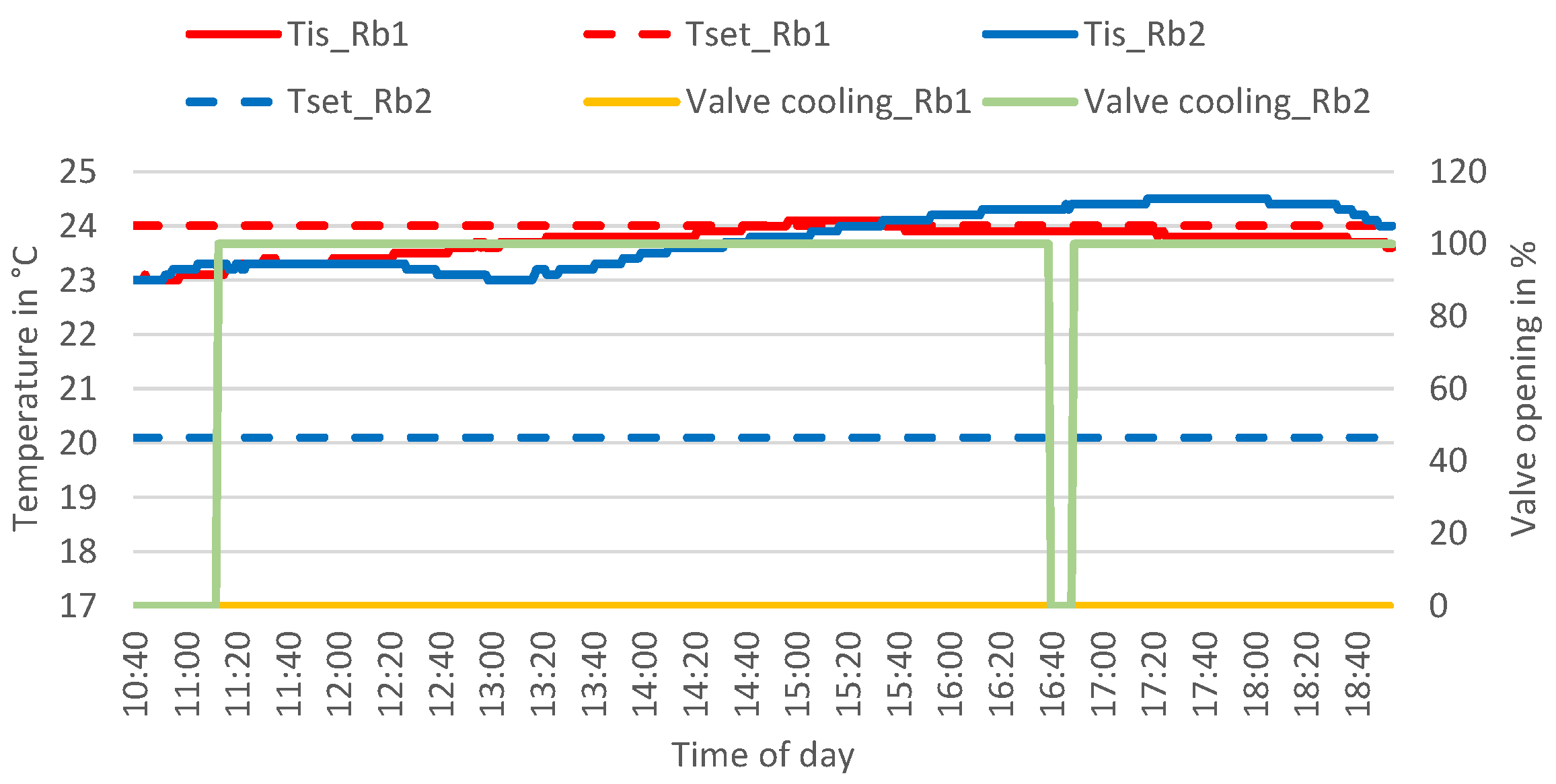
| Name | Type | Example | Description |
|---|---|---|---|
| Measured and metered values | |||
| Energy data | |||
| T_Co_in | real | 293.15 | in K, temperature into condenser |
| T_Co_out | real | 300.15 | in K, temperature out of condenser |
| T_Ev_in | real | 283.15 | in K, temperature into evaporator |
| T_Ev_out | real | 273.15 | in K, temperature out of evaporator |
| n | real | 300 | in 1/min, rotational speed |
| Pel_now | real | 10000 | in W, current electrical power |
| QflowUse_now | real | 20000 | in W, current thermal power |
| REDK | list | [R1, 0.2] | list with room energy distribution keys |
| Pel_Pos_max | real | 3000 | in W, maximum additional supplied power |
| Energy cost data | |||
| relevantCost | real | 150.0 | in W, electrical power to provide needed thermal power |
| BBB No. | Agents |
|---|---|
| BBB1 | Comfort agents for all rooms (4) |
| BBB2 | Room agent Room 1 |
| BBB3 | Room agent Room 2 |
| BBB4 | Energy supply agent pump heating |
| BBB5 | Energy supply agent pump cooling |
| BBB6 | Energy supply agent heat pump |
| BBB7 | Electricity info agent |
| BBB8 | All sensors (17) |
| BBB9 | All actuators (4) |
| Component | KPI | Unit | Value MAS | Value BM |
|---|---|---|---|---|
| Room 1 | Th. energy | kWh | 18.7 | 19.9 |
| Room 2 | Th. energy | kWh | 18 | 19.1 |
| Room 1 | Lost comfort | 3.1 | 6.2 | |
| Room 2 | Lost comfort | 8.5 | 3 | |
| Pump | El. energy | 0.45 | 0.23 | |
| Heat pump | El. energy | 112 | 124 |
© 2017 by the authors. Licensee MDPI, Basel, Switzerland. This article is an open access article distributed under the terms and conditions of the Creative Commons Attribution (CC BY) license (http://creativecommons.org/licenses/by/4.0/).
Share and Cite
Constantin, A.; Löwen, A.; Ponci, F.; Müller, D.; Monti, A. Design, Implementation and Demonstration of Embedded Agents for Energy Management in Non-Residential Buildings. Energies 2017, 10, 1106. https://doi.org/10.3390/en10081106
Constantin A, Löwen A, Ponci F, Müller D, Monti A. Design, Implementation and Demonstration of Embedded Agents for Energy Management in Non-Residential Buildings. Energies. 2017; 10(8):1106. https://doi.org/10.3390/en10081106
Chicago/Turabian StyleConstantin, Ana, Artur Löwen, Ferdinanda Ponci, Dirk Müller, and Antonello Monti. 2017. "Design, Implementation and Demonstration of Embedded Agents for Energy Management in Non-Residential Buildings" Energies 10, no. 8: 1106. https://doi.org/10.3390/en10081106
APA StyleConstantin, A., Löwen, A., Ponci, F., Müller, D., & Monti, A. (2017). Design, Implementation and Demonstration of Embedded Agents for Energy Management in Non-Residential Buildings. Energies, 10(8), 1106. https://doi.org/10.3390/en10081106







